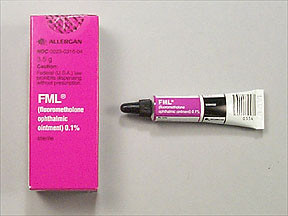FLUOROMETHOLONE OINTMENT - OPHTHALMIC
PHONETIC PRONUNCIATION: (flewr-oh-METH-oh-lone)
COMMON BRAND NAME(S): FML S.O.P.
GENERIC NAME(S): fluorometholone
Uses
USES: This medication is used to treat certain eye conditions due to inflammation or injury. Fluorometholone works by relieving symptoms such as swelling, redness, and itching. It belongs to a class of drugs known as corticosteroids.
How to use FLUOROMETHOLONE OINTMENT - OPHTHALMIC
HOW TO USE: Do not wear contact lenses while you are using this medicine. Sterilize contact lenses according to the manufacturer's directions, and check with your doctor before you begin using them again. To apply the eye ointment, wash your hands first. To avoid contamination, do not touch the tube tip or let it touch your eye or any other surface. Gently pull down the lower eyelid to make a pouch. Place a 1/2 inch (1.5 centimeters) strip of ointment into the pouch. Gently close the eye and roll the eyeball in all directions to spread the medication. Try not to blink and do not rub the eye. Repeat these steps for your other eye if so directed. Apply as often as directed by your doctor. Wipe the tip of the ointment tube with a clean tissue to remove extra medication before recapping it. If you are using another kind of eye medication (for example, other drops or ointments), apply the eye drops first and wait at least 5 to 10 minutes before applying this eye ointment. Use eye drops before eye ointments to allow the drops to enter the eye. Use this medication regularly in order to get the most benefit from it. To help you remember, use it at the same time(s) each day. The dosage and length of treatment are based on your medical condition and response to treatment. Do not use this medication more often or for longer than prescribed because doing so may increase your risk of side effects. Continue to use this medication for the full time prescribed. Do not stop using this medication without consulting your doctor. Some conditions may become worse when the drug is suddenly stopped. Your dose may need to be gradually decreased. Do not use this product if it becomes contaminated (for example, the ointment turns a dark color or develops particles in it). Use of contaminated eye medication can cause infection, serious damage to the eye, and loss of vision. Contact your doctor or pharmacist for more information. Tell your doctor if your condition does not improve after 2 days or if it worsens.
Side Effects
Precautions
Interactions
Overdose
Images
Reviews
Faq for FLUOROMETHOLONE OINTMENT - OPHTHALMIC
Fluorometholone ointment - ophthalmic is used to treat certain eye conditions, including inflammation and swelling caused by injury, infection, surgery, or other diseases.
Fluorometholone ointment - ophthalmic belongs to a class of drugs called corticosteroids. It works by reducing inflammation in the eyes, thereby relieving symptoms such as redness, itching, and swelling.
It is important to follow the instructions provided by your doctor or the medication label. Generally, you should wash your hands before using the ointment, tilt your head back, gently pull down your lower eyelid, and apply a small strip of ointment into the pocket that is formed. After applying, close your eye gently and keep it closed for a few minutes to allow the medication to spread evenly.
Common side effects may include blurred vision, stinging or burning sensation, increased sensitivity to light, dry eyes, and temporary eye discomfort. If these side effects persist or worsen, notify your doctor promptly.
Fluorometholone ointment - ophthalmic is generally considered safe when used as directed by a healthcare professional. However, like any medication, it may have some risks and potential side effects. It is important to discuss your medical history, allergies, and current medications with your doctor before using this ointment.
It is generally recommended to avoid wearing contact lenses while using this ointment as it may cause discomfort or interfere with the effectiveness of the medication. Consult your doctor or eye care professional for more guidance.
The duration of treatment will depend on the specific eye condition being treated. Your doctor will provide specific instructions regarding the duration of use. It is important not to stop using the ointment abruptly without consulting your doctor.
Disclaimer
IMPORTANT: HOW TO USE THIS INFORMATION: This is a summary and does NOT have all possible information about this product. This information does not assure that this product is safe, effective, or appropriate for you. This information is not individual medical advice and does not substitute for the advice of your health care professional. Always ask your health care professional for complete information about this product and your specific health needs.

No Reviews Yet